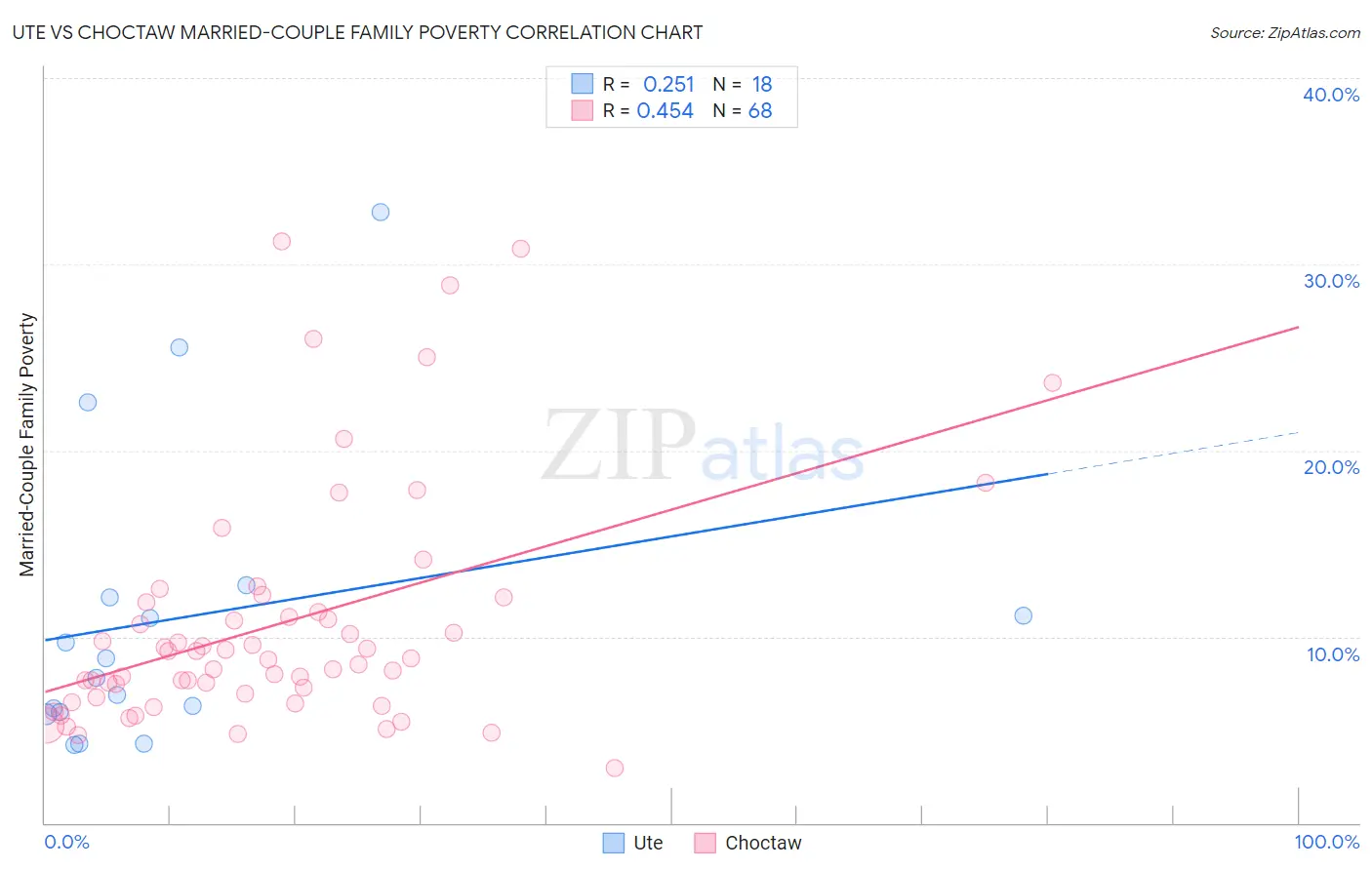Ute vs Choctaw Married-Couple Family Poverty
COMPARE
Ute
Choctaw
Married-Couple Family Poverty
Married-Couple Family Poverty Comparison
Ute
Choctaw
6.4%
MARRIED-COUPLE FAMILY POVERTY
0.0/ 100
METRIC RATING
283rd/ 347
METRIC RANK
6.3%
MARRIED-COUPLE FAMILY POVERTY
0.1/ 100
METRIC RATING
275th/ 347
METRIC RANK
Ute vs Choctaw Married-Couple Family Poverty Correlation Chart
The statistical analysis conducted on geographies consisting of 55,601,048 people shows a weak positive correlation between the proportion of Ute and poverty level among married-couple families in the United States with a correlation coefficient (R) of 0.251 and weighted average of 6.4%. Similarly, the statistical analysis conducted on geographies consisting of 268,584,402 people shows a moderate positive correlation between the proportion of Choctaw and poverty level among married-couple families in the United States with a correlation coefficient (R) of 0.454 and weighted average of 6.3%, a difference of 2.3%.

Married-Couple Family Poverty Correlation Summary
| Measurement | Ute | Choctaw |
| Minimum | 4.2% | 3.0% |
| Maximum | 32.8% | 31.2% |
| Range | 28.6% | 28.3% |
| Mean | 11.0% | 10.7% |
| Median | 8.3% | 8.8% |
| Interquartile 25% (IQ1) | 6.0% | 6.8% |
| Interquartile 75% (IQ3) | 12.1% | 11.6% |
| Interquartile Range (IQR) | 6.1% | 4.8% |
| Standard Deviation (Sample) | 8.0% | 6.4% |
| Standard Deviation (Population) | 7.8% | 6.3% |
Demographics Similar to Ute and Choctaw by Married-Couple Family Poverty
In terms of married-couple family poverty, the demographic groups most similar to Ute are Dutch West Indian (6.4%, a difference of 0.12%), Seminole (6.4%, a difference of 0.38%), Mexican American Indian (6.4%, a difference of 0.39%), Black/African American (6.5%, a difference of 0.63%), and Guyanese (6.5%, a difference of 0.73%). Similarly, the demographic groups most similar to Choctaw are Barbadian (6.3%, a difference of 0.16%), Colville (6.3%, a difference of 0.21%), Yaqui (6.3%, a difference of 0.45%), Indonesian (6.3%, a difference of 0.59%), and Trinidadian and Tobagonian (6.2%, a difference of 0.99%).
| Demographics | Rating | Rank | Married-Couple Family Poverty |
| Immigrants | West Indies | 0.1 /100 | #269 | Tragic 6.2% |
| Immigrants | Jamaica | 0.1 /100 | #270 | Tragic 6.2% |
| Immigrants | Bahamas | 0.1 /100 | #271 | Tragic 6.2% |
| Trinidadians and Tobagonians | 0.1 /100 | #272 | Tragic 6.2% |
| Colville | 0.1 /100 | #273 | Tragic 6.3% |
| Barbadians | 0.1 /100 | #274 | Tragic 6.3% |
| Choctaw | 0.1 /100 | #275 | Tragic 6.3% |
| Yaqui | 0.1 /100 | #276 | Tragic 6.3% |
| Indonesians | 0.1 /100 | #277 | Tragic 6.3% |
| Immigrants | Trinidad and Tobago | 0.1 /100 | #278 | Tragic 6.4% |
| Houma | 0.0 /100 | #279 | Tragic 6.4% |
| West Indians | 0.0 /100 | #280 | Tragic 6.4% |
| Mexican American Indians | 0.0 /100 | #281 | Tragic 6.4% |
| Seminole | 0.0 /100 | #282 | Tragic 6.4% |
| Ute | 0.0 /100 | #283 | Tragic 6.4% |
| Dutch West Indians | 0.0 /100 | #284 | Tragic 6.4% |
| Blacks/African Americans | 0.0 /100 | #285 | Tragic 6.5% |
| Guyanese | 0.0 /100 | #286 | Tragic 6.5% |
| Ecuadorians | 0.0 /100 | #287 | Tragic 6.5% |
| Salvadorans | 0.0 /100 | #288 | Tragic 6.5% |
| Nepalese | 0.0 /100 | #289 | Tragic 6.5% |